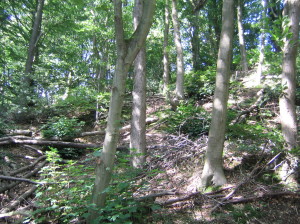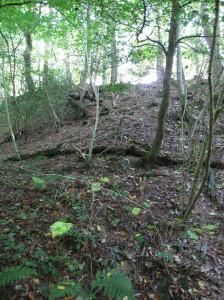 |
Left – This is what a management thin looks like. Felled trees left on the ground decay, are not replaced and the forest ecosystem is damaged. |
Why can “thinning” damage a woodland?
Because it’s not a natural event but a technique developed for growing timber trees. It’s very damaging of the health of the woodland community and is totally at odds with nature’s way of caring for the woodland. Unfortunately this has become widely accepted management practice, even amongst people who should know better.
The main reasons why a management thin is wrong are:-
* Absence of continuity. One major intervention then nothing for some years rather than a minimum year on year on year;
* Creates even-aged sanitised woodland with tree trunks clear of branches, a gross lack of diversity, absence of nest and seed sites and loss of diversity as smaller forest trees are shaded out (eg birch, rowan, alder);
* Initially dappled sunlight fitters through the canopy but within just a few years this closes over and the woodland becomes dark and drafty with a loss of insects;
* Shrubs and ground cover plants disappear eliminating shelter for such as stoats who assist by controlling the rabbits.
* Absence of decaying wood- branches, decaying trunks, and if not replenished, on the woodland floor, with a loss of recycled nutrients;
* As the woodland closes over, bird numbers and diversity reduces and in the gloom forest flowers die back. Even ferns retreat;
* Natural selection is disrupted. Stressed trees that are dying and old trees with hollows etc are generally removed;
So what should we do? By observing how nature intervenes we mimic a moth eaten blanket- as if a large tree has blown over and a shaft of light has penetrated the woodland (see question on glades).
|





